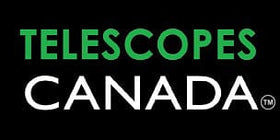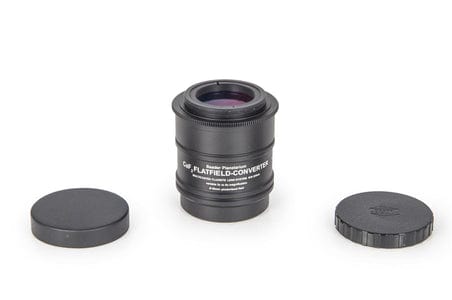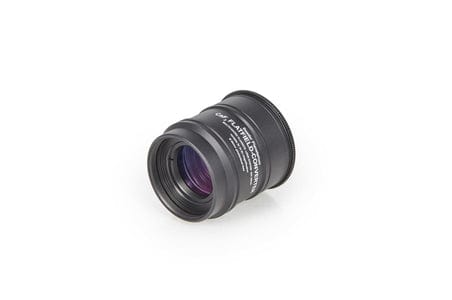Description
The CaF2 Fluorite-Flat-field-Converter can be combined with every optical system for photography and visual observations as best and most sophisticated Barlow lens in the world
- Apochromatic, fully multi-coated lenses (note: w. multi-coated Fluorite-lens faces
- Resolution in lines is 10x higher than that of the best projection eyepieces
- 90 mm image circle for medium format cameras
- The FFC fits on every T-2 thread and in every 2" focuser
For almost 20 years (as well as 20 years ago already) our customers had asked again and again: "Do you have a Barlow lens or projection eyepiece – but with a flat field – which can be used with medium format (6x7 Pentax) cameras for imaging sun, moon and planets, but without the typical loss of sharpness?"
This bothered us back in those times , and finally one of the designers of the Zeiss APQ lenses calculated the ultimate projection system with a flat image field in 1997. To actually make this design become reality, extreme types of glasses were needed. In this case, two multi-coated fluorite-lenses - at that time and until today - a nightmare to produce.
The result was an optical system with an unmatched sharpness, with a ten times higher resolution of line pairs than a Zeiss Abbe eyepiece. Even so the days of emulsion film cameras are long gone, this lens system has persisted to be "the sharpest Barlow ever made".
By changing the distance to the camera sensor, you can vary the magnification between 3x and 8x. The optimum line resolution is set at 4x magnification, then you have the full sharpness over an image circle of 90 mm diameter. On the axis, the sharpness is only limited by your telescope – even at a magnification factor of 15x. We have tested this at an AstroPhysics lens telescope. Slowly slowly even the large diffraction limited field of 90 mm will become of importance again - with the advent of ultra-fast and giant CMOS-cameras covering a field of 70 mm in diameter.
The FFC can be connected onto every T-2 thread and its 2" main body likewise fits into every 2" eyepiece clamp. With the help of our Astro T2™-System and the M 68-System you can connect it onto a whole world of telescopes.
For best results, you need to keep a certain distance to the original focus point. Please take a look at the PDFs in the Download-section for technical information
Eyepiece Projection - How Good Can It Get?
Customer Statement: The FFC on a Carl Zeiss APQ 130 - January 2004
When you are observing and photographing planets, the power and quality of each part in the chain is very important. The result is heavily influenced by design, material, polishing quality of the optical surfaces and the utmost in suppression of stray light. Even small optics can then deliver very good results.
About two years ago I had used the Fluorite-Flat-field-Converter by Baader for the first time ans was positively surprised. I could achieve a better contrast and resolution with the Baader FFC than with normal Barlow lenses of good quality.
I use the projection system with up to 8x magnification for taking photos of the planets. This is a rather long setup, and the price seems high, too. But it is well worth the money if you take a look at the build-quality and the achievable results. During the Mars-opposition in 2003 I could take some images with the APQ 130 and the FFC. For such a relatively small telescope, I think they are really pretty good!
Best regards
Dr. Harald Michaelis
Specifications
| EAN Code | 4047825009999 |
|---|---|
| Manufacturer | Baader Planetarium |
| SKU (#) | 2458200 |
| Weight (kg) | 0.239 |
| Inner Connection (lens sided) | Thread, T-2 (M42 x 0,75) |
| Outer Connection (lens sided) | Barrel, 2" (50,8mm) |
| Outer Connection (eyepiece/-camera-sided) | Thread, T-2 (M42 x 0,75) |
| Magnification (x) | 3x - 8x |
| AR-Coating | High transmission multi-coated (HT-MC) |
| Optical Design | Barlow |
| Specialty | Field Flattener |










